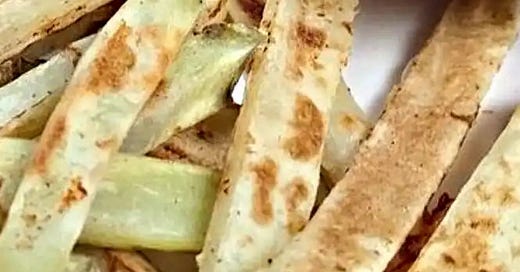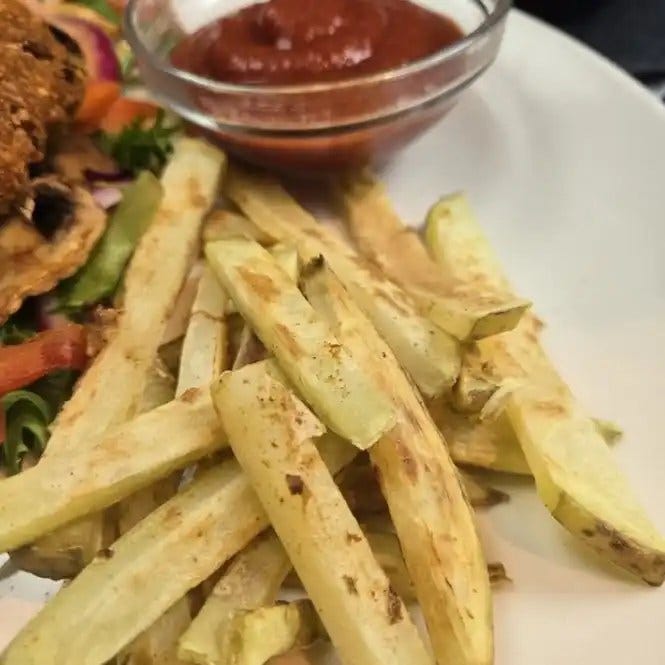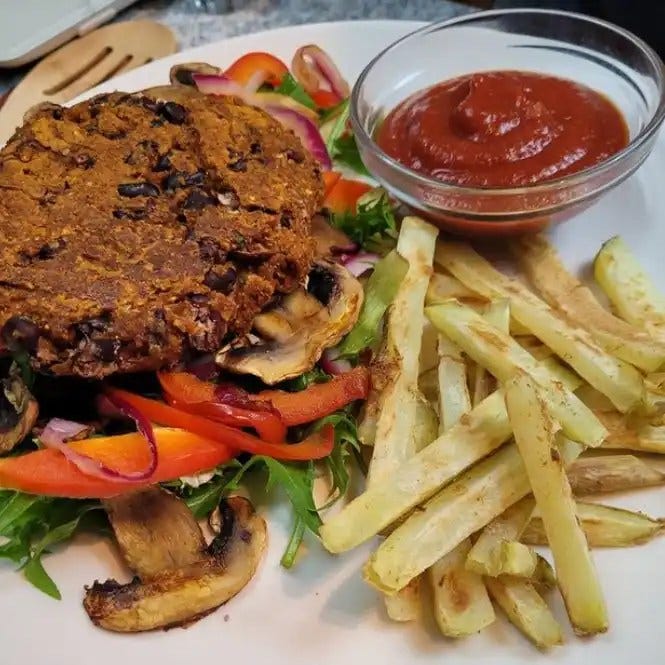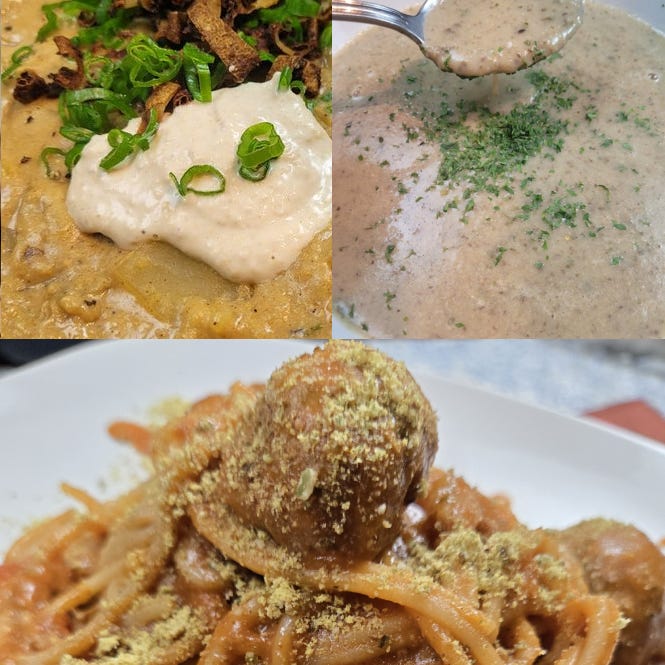These are the questions I had that spawned this article:
Everyone loves crispy fries but how can you cook them without oil, an oven, or raising blood sugars?
How can you remove pesticides from produce, and is organic produce really safer?
What’s the least amount of exercise I can do to see the fastest results?
Using science-backed resources we’ll look at what the latest research says for these questions and more, oh and also enjoy a warm side of fries.
📰 In This Issue
🌱 The Recipe - Oil-Free Stovetop Low GI French Fries
After creating the oil-free popcorn I mentioned French fries as another food that people think is impossible to cook without oil. Quite a few readers asked for oil-free stovetop fries so I wanted to share my technique and tips with you all.
These fries are nice and crispy on the outside and soft and tender on the inside, take less than 30 minutes, and won’t spike your blood sugars.
Find the recipe video and links and more below…
🌱 Washing Away Pesticides
Since I published January’s seasonal produce PDF last week I thought I would share a quick science-backed tip or two about cleaning pesticides.
Seasonal and even organic produce doesn’t mean that it’s pesticide-free. So what is the best way to remove pesticides from your produce at home? And what about orgainic?
A while back I mentioned that soaking in water and simple baking soda, even compared with something as harsh as Clorox® Bleach, is “…more effective in removing surface pesticide residues,” for at least 2 minutes, and then rinsing, as concluded from a study done in 2017.
More recent studies have found that 5 and 15 minutes had better results…
Read more below…
🌱 Excercise Update
I’ve updated, simplified, and expanded on quite of few sections of the Science-backed Smart Exercise article I posted last week. It shows some science-backed low effort fast results ways to either improve strength, lose weight, gain muscle, increase bone density, or all at once.
Check it out if you haven’t and let me know if you’d like more info or to expand on the article and include more info on stretching, combo exercises, low mobility (mostly for older adults or people with accessiblity needs) muscle and bone mass exercises, or anything else.
🍲 The Recipe: Oil-Free Stovetop French Fries
This healthier French fry uses science-backed hacks to lower the glycemic index/load and increase the resistant starch of the fries. So that way you can enjoy a side of fries without having to worry about your health (diabetes, heart disease, etc.) or them going straight to your butt/hips. Also checkout my quick & easy Healthy Ketchup Recipe or powders for popcorn or fries.
Subscribe on YouTube to never miss a video.
This recipe was originally posted on PlantBasedProof.com and you can find the full recipe and tips there.
no dairy, no eggs, no wheat, no nuts, no tree nuts, no shellfish, no seafood, no soy, no coconut, no salt added, no oil added, and no sugar added. Sesame free.
Oil-Free Stovetop French Fries
🔪 The Recipe: Oil-Free French Fries on the Stovetop
⏲️ Estimated Time: About 20-30 minutes
🍽️ Servings: Around 1 serving (¾ cup/serving)
💵 Cost to make: Around $0.15 USD / $0.22 CAD / €0.15
🕹️ Difficulty: Easy
Nutrition Facts
Serving size:
3/4 cup of fries
Nutrition Facts:
🔥 121.0 Calories (6.0% DV, based on 2,000 calories)
🧈 0.2g Fat (0.3% DV of 65g)
– 🥓 Saturated Fat: 0.0g
– 🚫 Trans Fat: 0.0g
– 🌰 Polyunsaturated Fat: 0.1g
– 🥑 Monounsaturated Fat: 0.0g
🥚 Cholesterol: 0.0mg (0.0% DV of 200mg)
🧂 13.0mg Sodium (0.6% DV of 2,300mg)
🌾 27.0g Carbs (0.8% DV of 400g)
🥬 2.9g Fiber (10.4% DV of 28g)
– 🍬 Sugars: 1.5g (3.0% DV of 50g)
💪 3.2g Protein (6.4% DV of 50g)
🍌 693.8mg Potassium (14.8% DV of 4,700mg)
🦴 19.0mg Calcium (1.5% DV of 1,300mg)
🔩 1.4mg Iron (7.8% DV of 18mg)
🌤️ 0.0mcg Vitamin D (0.0% DV of 50mcg/2000IU)
add cheap button mushrooms and maximize mushrooms to make your daily vitamin D 100%!🚱 Washing Away Pesticides
The most important takeaway from this is to eat your fruit and veggies! And wash them…
A study from 2011 found that the “substitution of organic forms” of the top 12 pesticide-filled produce items did “not result in any appreciable reduction of consumer risks.” So not eating organic might not be the end of the world. The main thing is to wash and eat your fruit and veggies even if you can’t afford organic or the time to soak and wash them as I recommend below.
In a recent study from 2019 they found that a 2% baking soda and a 15-minute soak reduced the pesticides by anywhere from “66.7–98.9%,” whereas only a washing with plain tap water had a “20–40%” reduction in pesticides.
The best method they found was Alkaline Electrolyzed Water removing 99% or more—although it isn’t an easy method, unless you have the money, or want to make one at home. (There are a few of DIY instructions online if you look and are handy) but it’s basic electrolysis that you might remember from grade-school science class.
That same study from 2019 concluded that spinach was most effective when washed with baking soda at 98.9% removal, but another study from 2022, on leafy veggies found that simply running water over the veggie was the most effective with a 77% reduction. Boiling veggies removed over 59.5% of pesticides when compared with a 2% baking soda solution for 5 minutes which removed “60% on average.”
So I personally use the following method, if you don’t have the expensive equipment:
Soak your produce in water and baking soda solution for 15 minutes
about 1 teaspoon of baking soda for every 1 cup of water (or roughly about 4.8g of baking soda for every 240 grams of water).
Wash or dunk your produce under running water, ensuring that all the baking soda is washed off.
Optional, wash/dunk and agitate your produce in pre-boiled, cold, and filtered water to remove any remaining baking soda and pesticides, as well as to remove any dangerous DBP (Disinfectant Byproducts) from the water.
This may all seem like extra work, but the soaking method alone might be less effort then some of us are currently doing (especially if you have a big bucket or pot), and the cost of the baking soda is so cheap and a lot less then the cost of much organic produce.
That all being said try to buy organic, if you can afford it, and if it’s an option. I still recommend the same treatment as above for organic because organic produce is still grown with pesticides that can be dangerous to ingest, just because something is natural/organic doesn’t mean that it can’t be dangerous to ingest or that it’s non-toxic.
So the main takeaway is: always wash and eat your produce no matter how it was grown.
🔜 Coming Soon
What do you want to see next?
🔗 PbP Resources
The 5-question reader survey is closing next week and I’d love to know what you want more of out of this newsletter, or send me a message.
The Science-Backed Research Links
Ingredients that Fight Disease - latest additions: Pumpkin Seeds, Sunflower Seeds, Raisins.
The Research on Diet and Disease- latest update: Genetics / Epigenetics
Substack Exclusive Mini Health Posts
Cooking Articles, Guides & PDFs
If you think others might find this newsletter useful then please share!
If you have any questions, concerns, complaints, or just want to chat then please feel free to contact me by hitting reply to this email, tapping the button below, or let’s connect on Instagram—I also just joined BlueSky!
That’s all for today. Stay healthy and nourished!
Happy cooking!
-Chef Robert Leigh
plantbasedproof.com
contact@plantbasedproof.com









The fries look great, could probably eat 4-5 servings of those . . . haha!